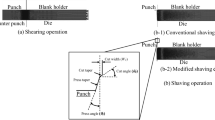Abstract
In recent years, increasing levels of precision of the cut surface characteristics in the cutting process of a metal die have become required not only for crack prevention but also for die roll prevention. The conventional shaving die is unlikely to be applied to achieve these requirements. As an innovative design, a novel modified shaving die with two steps of tapering, press and cut tapers, was designed and proposed in this research. The finite element method (FEM) was used to clarify the cutting mechanism and identify the effects of the process parameters and geometry of the shaving die of interest on the cut surface characteristics based on material flow and stress distribution analyses. The press taper limits the die roll formation on the sheared edge during the first stage of the cutting phase, and the cut taper prevents a new die roll from forming during the second stage of the cutting phase. The results showed that by using the novel modified shaving die, die roll formation could be reduced. Furthermore, by suitably selecting the process parameters and geometry of the shaving die, nearly zero die roll (nZDR) could be achieved. Laboratory experiments were carried out to validate the FEM simulation results. The FEM simulation results showed good agreement with the experimental results in terms of the cut surface characteristics and the cutting forces.










Similar content being viewed by others
References
Lange, K. (1985). Handbook of Metal Forming (p. 31). New York: McGraw-Hill Inc.
Sontamino, A., & Thipprakmas, S. (2017). Cut Surface Features in Various Die-Cutting Processes. Key Engineering Materials, 719, 127–131.
Haohao, B., Hao, S., Ruili, X., Liping, C., & Zhiqiang, Z. (2018). Finite Element Simulation of the Punch with Inclined Edge in the Sheet Metal Blanking Process. J Computing Sci Math, 9, 377–389.
Mori, K., Abe, Y., Kidoma, Y., & Kadarno, P. (2013). Slight Clearance Punching of Ultra-High Strength Steel Sheets Using Punch Having Small Round Edge. Int J Mach Tools Manufact, 65, 41–46.
Chenjue, Y., Jieshi, C., Cedric, X., & Xiangyu, Y. (2016). Study of Curvature and Pre-Damage Effects on the Edge Stretch Ability of Advanced High Strength Steel Based on a New Simulation Model. International Journal of Material Forming, 9, 269–276.
Li, M. (2000). An experimental investigation on cut surface and burr in trimming aluminum autobody sheet. International J Mech Sci, 42, 889–906.
Sachnik, P., Hoque, S. E., & Volk, W. (2017). Burr-free cutting edges by notch-shear cutting. J Mater Process Tech, 249, 229–245.
Martin, F., Ilja, K., Michael, K., Roland, G., & Wolfram, V. (2017). Reduction of burr formation for conventional shear cutting of boron-alloyed sheets through focused heat treatment. Procedia CIRP, 63, 493–498.
Djavanroodi, F., Pirgholi, A., & Derakhshani, E. (2010). FEM and ANN Analysis in Fine-Blanking Process. Materials and Manufacturing Processes, 25, 864–872.
Yiemchaiyaphum, S., Jin, M., & Thipprakmas, S. (2010). Die Design in Fine-Piercing Process by Chamfering Cutting Edge. Key Engineering Materials, 443, 219–224.
Ri-Xian, D., Cheng, G., Zi-Cai, Z., Ming-Kai, Z., & Rui-Peng, G. (2014). Piezoelectric-Based Non-Destructive Monitoring of Contact Pressures in Fine-Blanking Process. J Eng Manuf, 228, 927–936.
Phanitwong W, Sontamino A, Thipprakmas S. Experiment Analysis of the Feasibility of Shaving Process Applied for High-Strength Steel Sheet. Adv Mater Sci Eng 2016; Number 1634840.
Chung, W., Hwang, K., Kim, J., & Ryu, H. (2008). A Study on the Improvement of the Accuracy of a Shaving Process Using a Progressive Die. International Journal of Modern Physics B, 22, 5673–5679.
Thipprakmas, S., & Phanitwong, W. (2010). Finite Element Analysis of Shaving Direction Effects in Reciprocating Shaving Process. Steel Research International, 81, 1058–1061.
Thipprakmas, S., Phanitwong, W., Chinwithee, M., & Morkprom, T. (2010). Reciprocating Shaving Approach to Eliminate Crack and Burr Formations in Pressed Parts. Key Engineering Materials, 443, 201–206.
Cheng, L., Zhichao, C., Kui, Z., Xinran, Y., & Xianglin, Z. (2017). A novel method to significantly decrease the die roll during fine-blanking process with verification by simulation and experiments. Journal of Material Process Tech, 250, 254–260.
Bo, T., Yanxiong, L., & Huajie, M. (2017). Investigation of a novel modified die design for fine-blanking process to reduce the die-roll size. Procedia Engineering, 207, 1546–1551.
Yanxiong, L., Bo, T., Lin, H., & Huajie, M. (2018). Investigation of a novel modified die design for fine-blanking process to reduce the die-roll size. Journal of Material Processing Technology, 260, 30–37.
Sontamino, A., & Thipprakmas, S. (2019). Development of a shaving die design for reducing rollover. Journal of Advanced Manufacturing Technology, 103, 1831–1845.
Sontamino, A., & Thipprakmas, S. (2019). Shearing clearance and shaving allowance to minimize die-roll formation in shaving process. Procedia Manufacturing, 29, 361–368.
Diewwanit, O., Keawcha-um, P., Keawcha-um, T., Petchhan, W., & Thipprakmas, S. (2021). Microstructural evolution and fracture mechanism for scar defect formation on advanced high strength steel during a shearing process. Journal of Manufacturing Science and Engineering, 143, 061008.
Thipprakmas, S., & Sontamino, A. (2020). Fabrication of clean cut surface on high strength steel using a new shaving die design. Journal of Mechanical Science and Technology, 34, 301–307.
Acknowledgements
This research was supported by The Thailand Research Fund (TRF) under Grant No. RSA6180047. The authors would like to express their gratitude to Wiriyakorn Phanitwong, Ph.D., Department of Industrial Engineering, Rajamangala University of Technology Rattanakosin, for her help with this research.
Author information
Authors and Affiliations
Corresponding author
Additional information
Publisher's Note
Springer Nature remains neutral with regard to jurisdictional claims in published maps and institutional affiliations.
Rights and permissions
About this article
Cite this article
Thipprakmas, S., Sontamino, A. A Novel Modified Shaving Die Design for Fabrication with Nearly Zero Die Roll Formations. Int. J. Precis. Eng. Manuf. 22, 991–1005 (2021). https://doi.org/10.1007/s12541-021-00509-x
Received:
Revised:
Accepted:
Published:
Issue Date:
DOI: https://doi.org/10.1007/s12541-021-00509-x



